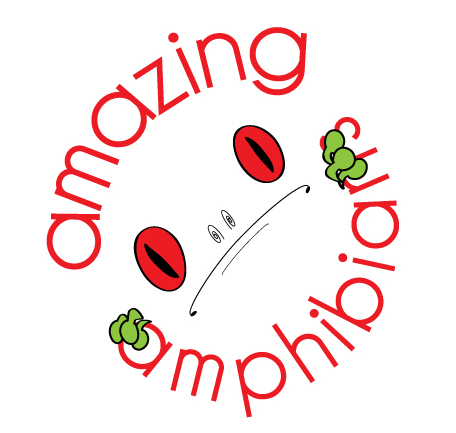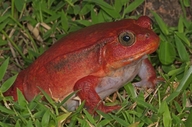|
Description
A large conspicuously coloured frog. M 60-65 mm, F 85-105 mm. Morphology as D. guineti. Colour uniformly yellow-orange in males, orange-red in females, sometimes with dark colour below dorsolateral folds (Glaw and Vences 2007).
Similar species: Very similar and possibly conspecific to D. guineti which differs by colour pattern (Glaw and Vences 2007). Distribution and Habitat
Country distribution from AmphibiaWeb's database: Madagascar
Located at Andevoranto, Antongil bay, Fizoana, Iaraka, Maroantsetra, Rantabe, Voloina (Glaw and Vences 2007) from sea level up to 600 m asl (Raxworthy et al. 2008).Life History, Abundance, Activity, and Special Behaviors
Habits: This species is very common in the Antongil bay area, especially in the town of Maroantsetra where it inhabits most gardens and breeds in ponds and ditches. Here, locals are familiar with this frog and can quickly find them when required as tourist attraction. These frogs have very sticky skin secretions which can produce local swellings in humans. Specimens breed regularly after rainfalls (no particular explosive breeding behaviour) and can be observed all-year round after rains. 1000-1500 small black eggs are laid and hatch 36 hours later (Glaw and Vences 2007).
Calls: A series of short low-pitched notes which is repeated after some intervals. The Malagasy name for this frog “Sangongon” is based on these sounds (Glaw and Vences 2007).
Trends and Threats
A 2017 reassessment by IUCN listed this species as Least Concerned (LC) due to its local abundance and apparent stable populations especially in and around Maroantsetra and in Ambatovaky (IUCN 2017).
From 2002 to 2016, this species was listed as Near Threatened (NT) because its extent of occurrence is probably less than 20,000 km2, but the species is adaptable and survives well in disturbed habitats (Raxworthy et al. 2008). Pollution of waterbodies is a potential threat, and in the past this species was subject to collection for international trade, although this is now largely under control and restricted (Raxworthy et al. 2008).
Conservation actions: It occurs in the Réserve Spéciale d’Ambatovaky and probably in Parc National de Masoala. This species is sometimes bred for commercial purposes outside Madagascar, and many specimens exchanged in the pet trade are captive bred. Captive breeding programmes and the CITES Appendix I status of this species have effectively halted commercial exploitation of it in Madagascar (if indeed this was ever a major threat), and any future trade in it needs to be well regulated. There is a well-managed captive breeding programme involving many US zoos, and it is now also kept in a zoo in Madagascar. Further taxonomic work is required to resolve confusion between this species and D. guineti (Raxworthy et al. 2008). Possible reasons for amphibian decline Local pesticides, fertilizers, and pollutants
Intentional mortality (over-harvesting, pet trade or collecting)
Comments
Taken with permission from Glaw and Vences (2007).
 Featured in Amazing Amphibians on 7 October 2013 Featured in Amazing Amphibians on 7 October 2013
References
Glaw, F., and Vences, M. (2007). Field Guide to the Amphibians and Reptiles of Madagascar. Third Edition. Vences and Glaw Verlag, Köln.
IUCN SSC Amphibian Specialist Group. (2017). Dyscophus antongilii. The IUCN Red List of Threatened Species 2017: e.T6937A84159360. http://dx.doi.org/10.2305/IUCN.UK.2017-2.RLTS.T6937A84159360.en.
Raxworthy, C., Vences, M., Andreone, F., and Nussbaum, R. (2008). Dyscophus antongilii. In: IUCN 2008. 2008 IUCN Red List of Threatened Species. www.iucnredlist.org. Downloaded on 08 April 2009.
Originally submitted by: Miguel Vences and Frank Glaw (first posted 2000-12-13)
Edited by: Kellie Whittaker, updated Ann T. Chang, Michelle Koo (2018-01-19)Species Account Citation: AmphibiaWeb 2018 Dyscophus antongilii: Tomato Frog <https://amphibiaweb.org/species/5530> University of California, Berkeley, CA, USA. Accessed Nov 21, 2024.
Feedback or comments about this page.
Citation: AmphibiaWeb. 2024. <https://amphibiaweb.org> University of California, Berkeley, CA, USA. Accessed 21 Nov 2024.
AmphibiaWeb's policy on data use.
| 